Tuesday, October 20, 2009
Tuesday Night Notes
~~~
Tampa is looking at a transit tax in 2020. By the time they implement it and build something, I'll be 50. When I think about all the things that happened between 1950 and 1970 I'm amazed that we can move with such sloth these days.
~~~
Houston residents are getting ancy about their lack of euclidean zoning regulations. I kind of like the lack of definitions inside the loop. It's a nice experiment in what can happen, even though there really are parking and setback regulations.
Monday, October 19, 2009
Four Two Through
For example I believe downtown Oakland was a little hamstrung when BART decided to split off trains to Fremont before going through a downtown Oakland station. With four lines instead of two going through downtown Oakland, it seems like it could have changed Oakland's equasion. Currently there is high frequency in the morning and evening rush, but at other times it could really use more trains into and from San Francisco. When there are opportunities to provide more service to a major destination, it seems like more service is a wise move that might be able to set the table for other improvements.
A Small Charge
Sunday, October 18, 2009
And I'm Back in the Game! Italy Blogging
I don't have as many transit pictures from this trip as I wasn't in cities as much. I did visit Milan and Turin and got a couple of streetcar, bus, and train shots but i'll share those later. I also took a lot of different modes of transportation, basically everything except a bike which i've already gotten crap for on facebook :) The final tab is such: Car, tram, train, subway, bus, cog railway, arial ropeway (tram), boat, plane, taxi, foot. Lots of foot. I did see a lot of bike sharing in small towns which was surprising and I really enjoyed my boat rides, which I don't do much here. In any event, here are some of my favorite places from the trip. I'll get back to regular blogging tomorrow.
The beaches were mostly stones

This is Zoagli (Zwal-e) The towns on the coast hug the hills

In Zoagli we got to see how silk and velvet fabric was made
We drove through the Alps on Mountain Roads

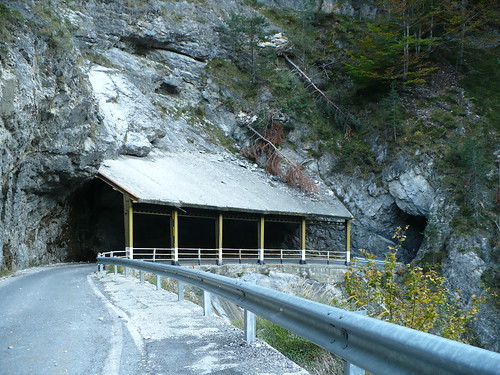
See the three portals for the road?

Drove through the upper lakes, prettiest bus stop ever?
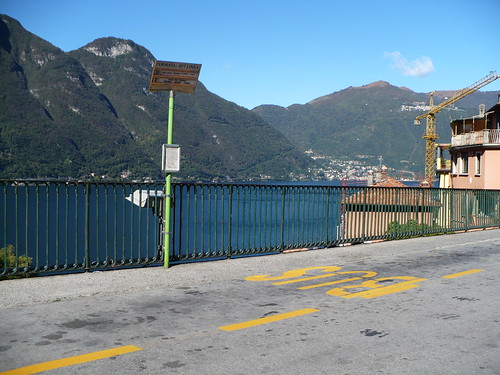

Scene from the top of the aerial ropeway
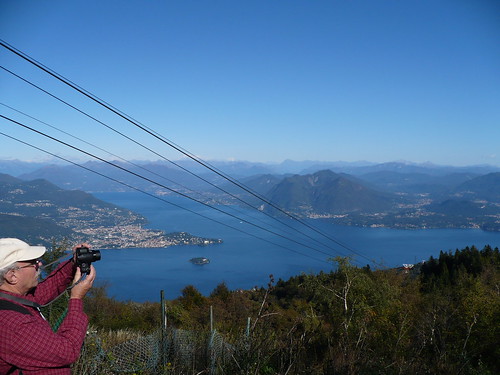
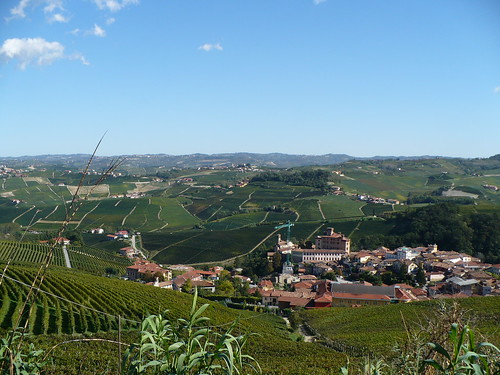
Portofino was nice

My Great Grandparents likely graced these spots in the hills above Chiavari in a small commune called Ne. It was really great to see where at least part of my past came from. The terraced hills are everywhere, these are for olive trees.


The Cinque Terre was amazing
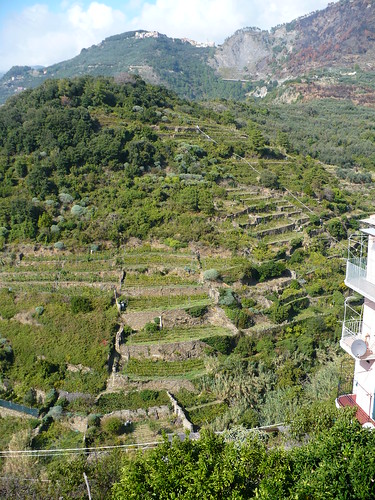
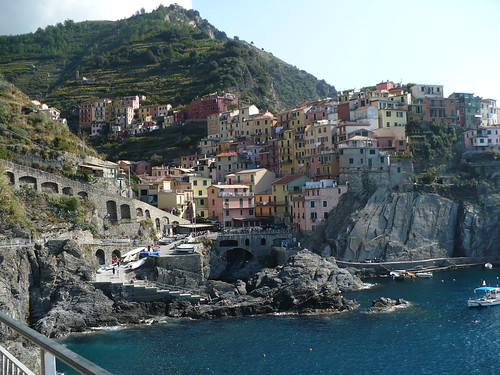
and the water was blue, but a color I had never seen.
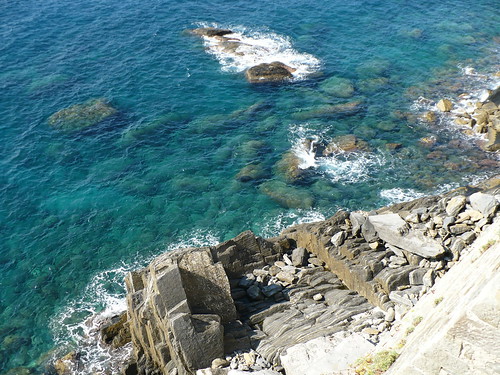

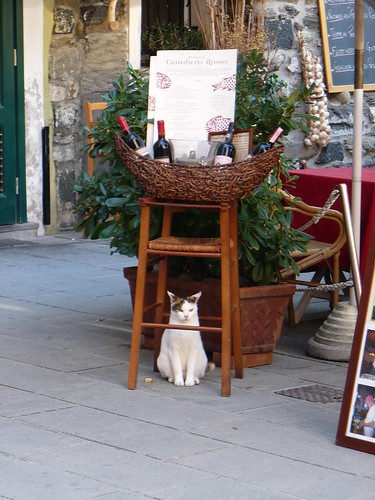
It was a great way to take a break. I highly recommend going to Italy, especially the Piedmont south of Turin.
Thursday, October 15, 2009
Replay 8/7/08: What if the Trams Were Gone?
Wednesday, October 14, 2009
Monday, October 12, 2009
Replay: 10/09/08 Patriotic Beer Redux
Ah. That's the way patriot. Let the OPECs keep their gasoline. We'll just tap into a far more efficient energy source. Man....power. If we all learn to pull our weight. Nobody, nobody will be able to siphon away, our high life.
HT Twin Cities Streets for People for the Reminder.
Sunday, October 11, 2009
Replay: 10/07/07 Transit and Acupuncture
So now I had to get to the acupuncturist in Montclaire. I left an hour before the appointment as the 59 comes every hour from Lake Merritt BART. I sat in the back of a 30 foot VanHool bus and watched the really nice houses pass by on the hills. It was actually a nice ride if not a little bumpy. But there was a catch. My appointment was going to be over at 5 but the last 59 went to the Rockridge BART at 4:15 or so. Not good. So I had to figure out a way back. Well where the 59 dropped off the 18 picked up and I was lucky enough that it ran every 15 minutes into the evening. So when I was done at 5 I hopped on the 18 and traveled on the other side of the hill from the 59. It took me to the 12th Street BART station and I hopped on the 24th street and mission turn around train to go home since I wouldn't be going to my Gramma's house.
I was thinking a bit negatively that there wasn't a 59 but my roommate pointed out that we are lucky to live in a fairly transit friendly place in the bay area and the fact that there was an 18 at all was good. It was still at 15 minute headways so yes, that was pretty good. I imagine that if I were in Houston or somewhere else this wouldn't have worked. So my car died, but i knew that I could depend on transit to get me where I needed to go. It took a little more time, but I got to watch the world go by instead of having to slog through traffic.
Thursday, October 8, 2009
Replay: 10/25/08 Urban Bumper Sticker

I've got the longhorn patch which has brought me closer to fellow Texans randomly on BART and the Hey Mercedes buttons of my favorite band that have gotten comments from some rock kids. Though no one has said much about the SF Municipal Railway or the Market Street Railway pins, it might be because we're usually smooshed together on the J Church.
The thing though is that unlike bumper stickers, you have to be in close quarters to see what the pins and buttons say, which makes people a bit more cordial than if they were in the space of their own car. No honking on transit.
Wednesday, October 7, 2009
Replay 6/9/07: Ipod As the Great Transit Equalizer
It’s funny but I think the advertisements for Apple’s IPod are fairly accurate. Especially in
Now with the IPod, we can have thousands of songs in a device that is the same size of our wallet, allowing us to listen to whatever we want to, whenever we want to. But while the IPod can be hooked up to the car, it seems to be more useful from a transportation standpoint to walkable transit oriented neighborhoods. When you get out of a car the radio turns off or there is a tape transition, but when you leave a train or bus, the music continues on kind of like a soundtrack to your life.
In my opinion, it’s this soundtrack quality that can give transit a bonus versus the car. There are many songs that if I play them in my car they bring back memories. Specific places on a road from Austin to Houston when I would drive home for Christmas or Thanksgiving are imagined in my head when I listen to the particular song I like to play on that stretch of road. Since I had a CD changer in my trunk and not the front deck I would even pull the car over to switch CDs if the one I wanted for that certain section of road was not available in the changer.
Now I’m finding that I’m having similar experiences with transit and my Ipod. However instead of just in the car, I have it for walking around the city, places along bus routes and inside of department stores. It even allows me to drown out the awful music at say the Gap or other places where they try to match the brand with music types. Well what if I want to shop in the Gap or Target listening to some metal or opera? They wouldn’t play those over the speakers but with the great equalizer we can.
There might be some drawbacks including awareness of your surroundings that might lead to some unfortunate altercations with automobiles or with the less desirable and under discussed elements of city life. There is always an issue of being social as well; shutting people out by just having headphones on is easy. But if anything, the great equalizer is incredibly more social than say an automobile. People in their own pods of space cut off from having to deal with social situations has led to rises in the instances of road rage however I’ve never heard of anything called Pod Rage. It might exist but from what I’ve seen, people are generally passive when bumped into with their IPod versus people bumped into who don’t have one on.
There is a serious issue that should be discussed as well with regards to hearing though. I know I’m guilty of listening to my IPod much louder than I should if I’m in a subway to drown out the external noise. However this could lead to long term hearing damage and such is said your eardrums are like lobsters, once their cooked there is no going back. I’m thinking about whether I should get noise canceling headphones or just read with earplugs which might be a soundtrack setback.
But with all that being said, I see the Ipod and MP3 players in general as a great transportation equalizer. You can create a soundtrack of songs you like but now it won’t apply to just your car but rather memories and experiences of life in general.
Sunday, October 4, 2009
Replay: 10/05/07 Collapse and Civilizations
I would however like to share something I wrote up on the plane ride over to Vienna...
I’m sitting here on a KLM flight to Amsterdam then to Vienna Austria for vacation with my family in Eastern Europe. The seat to my left is empty and the movie Oceans 13 just finished but I noticed something so true. Earlier there was a man sitting next to me from Visalia. It’s a small town in Central California where agriculture is the lifeblood of the community. Earlier I overheard him talking to the man on his left from Stockton, which is quickly becoming a bedroom community for the Bay Area. He asked what he did for a living and the man replied “I’m a developer”.
Now I’m not usually one to listen in but of course being an urban planner I had to hear what was coming next. The man from Visalia was uncomfortable in his seat being about 6’4” or so. Of course these planes are more like cattle cars than luxurious transportation but his knees were sitting in the cracks of the seats in front of us and his elbow was in my ribs. But he continued cheerily talking asking the developer, if there was any more room to build in Stockton because of the disappearance of farmland. The man from Visalia asked, “Why don’t you build up instead of out?” The developer replied, “There is plenty of land left to build on.” Under my breath I said “Yeah right” realizing what kind of developer he was.
The man from Visalia kept going on about resources and conservation and even ended up discussing taking vegetable oil from fast food restaurants for reuse. He then moved on to me asking what I did. I said “I’m an urban planner.” He seemed surprised. “That guy next to me is a developer.” I nodded and said “Yes I heard.” He asked what I did specifically and I told him. He then went on to discuss his former job as a parole officer and the travesty of the red car. “The Mayor was a crook” he said. “Ripping out all those streetcars.” People I talk to always seem launch into the benefits of transit without provocation. I never prodded him or even told him about my thoughts on the subject but he told me about it anyways. He was around for the red car and seemed specifically upset about their demise. “You’d never be able to build it back today” he said. I told him they were trying.
Throughout the flight he kept getting hit in the knees by the lady in front of us who tried to lean her seat back. He had to protest each time which led him to ask to move seats. The flight attendant was more than happy to help him out so he was out of there leaving me and the developer an empty seat between us. As we both put our stuff on the tray table where the man from Visalia was sitting I noticed the book he put down juxtaposed with the one that I put down. His was a hardcover deep crimson red book titled “Empire”. Mine was a softcover book by Jared Diamond called Collapse about the collapse of several civilizations throughout history by climate change among a number of other factors including war and societal suicide (ie: Easter Island). It really stuck in my head the difference between the two sets of warring factions in the sprawl fight. The ones who think there are endless spoils to be had and a never ending supply of resources, and those who are looking to avoid a collapse. I’ve never seen the fight in such black/white or good/evil terms and probably will never again because of course it is never so simple. I’m not a hardcore environmentalist or anything but for a moment there I realized why I do what I do.
Saturday, October 3, 2009
Away From Computers
Friday, October 2, 2009
Quote of the Day
"The LRT is not just about moving people," says Bob Boutilier, the general manager of the city's transportation department. "It's about building a city."I wish more transportation leaders would get this simple point.
Payback Time
Thursday, October 1, 2009
Demand
Transportation Secretary Ray LaHood’s $1.5 billion discretionary grant pool won’t come anywhere close to meeting its requests, as states and other transport groups sent in applications for $56.9 billion to cover highway projects as well as transit, rail, seaport and other construction needs.
Tuesday, September 29, 2009
Tuesday Night Notes
~~~
Is City Living the way to a wealthier nation? I'm not sure if it's just city living. I think it's creation of wealth through location efficiency. But currently our rules are set up to not let that happen.
~~~
Charlotte is master planning at the North End rail yards south to Dilworth. Wonder if they are thinking about the Ringstrasse? Could tie it together quite nicely.
~~~
El Paso - Juarez Commuter Rail?
On Tuesday, Juarez Mayor Jose Reyes Ferriz and most of the Juarez city council accepted a resolution from the El Paso city council, saying the two cities will work together to create a commuter line between the sister cities.
Football Stadiums
Chargers officials have said the site in Escondido is especially attractive because it's close to the Sprinter light rail line and freeways that provide easy access to San Diego, coastal North County and Riverside County.Is it just me, or are all football stadium planners just transportation illiterate? Maybe it doesn't really matter 8 days a year.
What You Make of It
Living here in San Francisco and visiting Chicago last weekend has shown me that honest urban places in the United States are hard to come by. And the reality is that in certain stages of a persons life, there is an opportunity and want to live this lifestyle that is often forgone for lack of availability. While my lifestyle in Austin during my last two years was fairly urban by Austin standards, I don't feel like the experience even closely matches up to what I've experienced here in San Francisco.
I also consider myself very lucky to live here, mostly because urban living can be expensive due to its popularity. But it's a trade off. It's trading road rage for crazy bus riders. It's trading a larger apartment for a smaller one and a pub around the corner you can head to if you're feeling cramped. It's trading a large yard for dolores park.
Rosenthal wonders whether similar measures could fly in the United States: "I believe most people are pretty adaptable and that some of the necessary shifts in lifestyle are about changing habits, not giving up comfort or convenience."It's all about what you're up for but the urban lifestyle isn't for everyone. There are however enough people out there that want it despite what a lot of waning popular wisdom will tell you.
Sunday, September 27, 2009
Sunday Night Notes
~~~
Check out these two pictures of neighborhoods. It really shows the difference between connected places and disconnected suburbs.
~~~
400 miles of new road is really too much. And this is the most ridiculous quote ever:
The strategy is based on decades-old migration and birth statistics and on existing land- development rights. Long-range plans for roads to serve non- existent cities don't foster speculative sprawl, the planners say; they anticipate what's already in the works.So basically they are anticipating and developing for sprawl. That's the most round about way to deny and prove the same thing at once I've ever heard. And it begs the question again why they can't build anticipatory rail lines without people yelling that no one uses them.
~~~
Tram construction is blamed for rents dropping in Scotland. I wonder when they are going to develop a faster way to do these things.
Thursday, September 24, 2009
Thursday Night Notes
~~~
Paz takes a look at TOD at Castle Shannon. I agree with him that transit agency parking lots often get in the way of good place making.
~~~
Siemens has built high speed trains for Russian winters, they hope they can build them for America as well.
~~~
The GAO has a report out on affordable housing and TOD.
~~~
Is there just a little bit of cognitive dissonance on the issue of growth boundaries in Portland? People understand that they save farmland by doing infill development and over 80% in a recent survey support that. But when asked if they want higher densities near them, it's 42% no. Perhaps if they were told how much it would save them in taxes?
~~~
Yup, no one is in charge. Politics, not intelligence governs Bay Area transport policy.
~~~
Circle line BRT is dead. That's kinda good, maybe they'll do it right next time.
Tuesday, September 22, 2009
Tuesday Night Notes
The industry has warned targets are market interference and will limit home builders' ability to provide as many single-family homes as buyers want.~~~
Recent zoning code increases allow value along the light rail line in Tempe to increase at a greater rate than similar areas in the region. It's interesting because similar areas in Phoenix are limited in their growth potential.
~~~
I'm really excited to go to Italy next month, especially Turin.
~~~
Orinda might be up for medium density around the BART station downtown. I think it would be cool if they made it look Tuscan.
~~~
Freeways are big priorities, especially those big beltway gifts to sprawl.
Catenary and Trolleywire
Some versions can be pretty ugly such as New Jersey Transit's catenary:
 Photo Courtesy HeritageTrolley.org
Photo Courtesy HeritageTrolley.orgHere's a crossover in Charlotte and a long straight stretch.
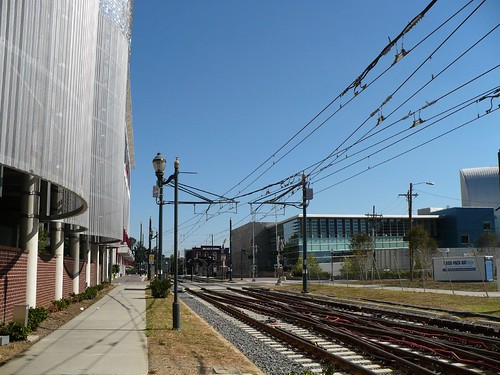
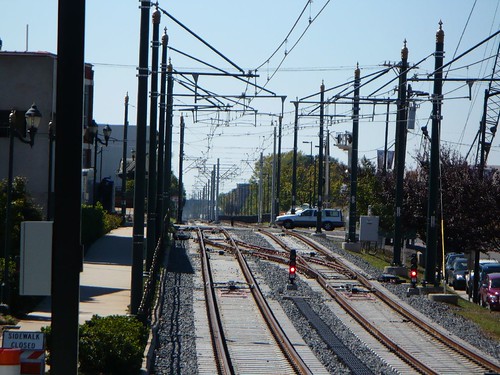
Unfortunately this is sometimes the ugly that people think about when they think about overhead wires. While it's music to my lungs, many other people don't feel the same way.
The catenary differs from a simple trolley wire suspension in that there are more wires as well as generally more visual obstruction. The catenary is used for higher speed lines because the tension created in the wire is great enough to keep the pantograph from bouncing up against the wire which can cause great damage. Ultimately trolleywire is perfectly good for streetcars in cities and I would generally believe that it's probably the first consideration of designers of modern streetcar systems.
Below is a Combino Supra under trolley wire.
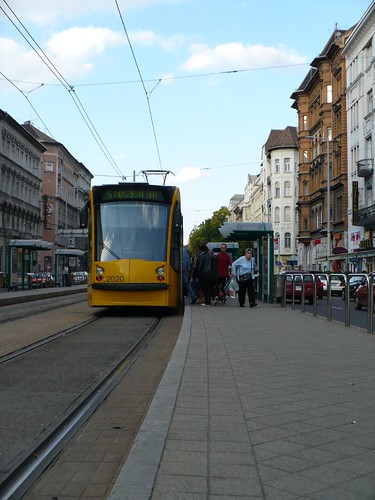
More Budapest
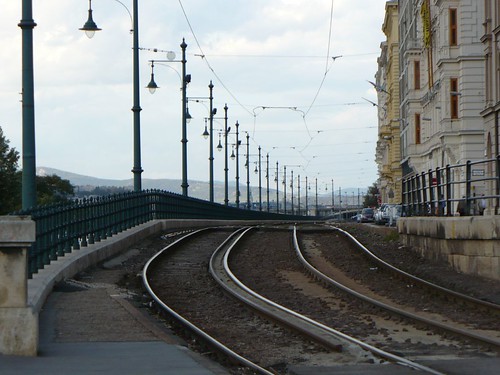
Some fun images from 1924's Electric Railway Handbook


Monday, September 21, 2009
Why the Catenary Talk?
"Do you want to be one of the last streetcars with a catenary system, or the first with a new system - that's the dilemma," Nadolny said.What streetcar actually needs catenary? Simple trolley wire will do. Some interurban lines could run up to 90mph on trolleywire. I don't see why we have to always over-engineer these things. If you want to ugly things up, go ahead and build catenary. Perhaps that is the goal since the idea of wireless streetcars is all the rage.
"We Don't Dwell"
Now we can add Phoenix to the list of FTA model lowballing:
The rail was projected to attract 26,000 riders per day, but the number is closer to 33,000, boosted in large part by weekend riders.What kills me about all this lowballing, is what the cost effectiveness number was, and what it SHOULD have been. Ultimately that is what decides projects. And it's a little messed up that the FTA keeps getting it wrong, especially when they can kill a project because of a CE below Medium. Oh, and here's the money quote from the opponents:
Starlee Rhoades, the spokeswoman for the Goldwater Institute, a vocal critic of the rail’s expense. “I’ve taken it,” Ms. Rhoades said, slightly sheepishly. “It’s useful.” She and her colleagues still think the rail is oversubsidized, but in terms of predictions of failure, she said, “We don’t dwell.”That's right, you're in the New York Times saying the light rail is useful and full of people after you said no one would ride it. In fact, your institute is just like every other that goes around and spreads doom and gloom everywhere. And what is the fascination with subsidies? I guess I'll never get that end of the argument.
...
“We are also proponents of paying your own way, and we think the light rail remains too subsidized.”
The Ads Begin
The only other city that has been made to vote on passenger rail even if it didn't include a bond measure or sales tax increase is Austin. Other cities including Denver and Houston decided to build the first line and found that it was a pretty good idea, so voters raised taxes on themselves to expand them. So Issue 9 begins in Cincinnati and here is the first ad in the fight against a ballot measure that would make the public vote on any amendment having to do with passenger rail, including commuter, streetcar, or even high speed rail.
Thursday, September 17, 2009
Non Highway Users Anonymous
Now it does come back to transit etc, but you're not paying directly for what you're using. I do pay a user fee now when I go over the bay bridge to my Gramma's house. And for the most part that $4 charge keeps me taking BART, which is faster anyway to downtown Oakland. But these tea party cries of socialism fall on deaf ears when you know these same people LOVE the socialism of roads. They even love the community good of transit. So much so that when it doesn't work, they get angry that government isn't doing a job they didn't fund it enough to do. Oh the irony.
Wednesday, September 16, 2009
Midweek Notes
~~~
Vancouver does Granny Flats in high rises.
~~~
Seattle Mayoral candidate McGinn is floating ideas for another light rail election in two years. But by light rail does he mean rapid streetcar or light metro?
~~~
A dustup over trolley buses in Seattle. I'd be interested to see if the bean counters actually did a lifecycle analysis considering how long electric trolleybuses actually last. Anyone who takes away existing hydro powered transit and replaces it with diesel needs a head check. It's unfortunate that it is even being discussed at all.
~~~
The economy isn't being so kind to mixed use projects in Atlanta.
Tuesday, September 15, 2009
Tuesday Night Notes
~~~
Kemper Freeman really doesn't get the gold mine he could be standing on.
~~~
Apparently the Lehman collapse has slowed Caltrain's electrification. From house testimony:
Losses in our county alone, for example, include: $25 million in San Mateo County Transit Authority funds that will stall planned electrification of the Caltrain Peninsula Commuter Rail Service
Monday, September 14, 2009
Running Scared
According to Greg Cohen, president of the American Highway Users Alliance, the changing partisan guard in Washington has made highway groups wary of the focus on transit funds. “People are much more nervous about being on the chopping block,” he said. “It seems like the anti-highway crowd has much more influence than they had in the past.”Anti highway? How about pro livable communities.
Depending on Obama's FTA
But the council's Democratic majority said it was important to get the project started. They hope the federal government will change its rules to pay for streetcar construction, and they argued by spending the money now the city would be first in line.
Get Off My Grass Track
I would also say that many highway projects that are being built today wouldn't make it through this process so to call them pork shows the lack of understanding. The Mayor of Stamford who has a BRT project in final design even goes as far as to say McCain doesn't get it.
The SUT project will also be a model of livability and sustainability, optimizing the use of the SITC and its 225 commuter trains and hundred of buses a day, supporting the development of LEED-certified and green buildings for 12,000 new residents and highly-paid workers, and reducing vehicle miles traveled by 18,900,000 per year.True colors coming through every day. 18 million VMT is a lot less foreign oil.
Freeway Swing
This is no small chunk of life and as we have seen, it was devestating to the economic vitality that cities would have maintained. As Scott Bernstein always says, urban places are the way we can build wealth. Unfortunately a whole lot of wealth was transferred and reallocated. It might be interesting to see what that 26% swing meant over time for the economics of the United States considering how much of the population lives in metro areas. We might be having different discussions today about sustainability.
Blogging Sustainability
With that being said, this isn't a GBCW post. Rather, it's just an announcement as to why things might seem a bit slower or less frequent. I'm still excited about this stuff. It still boils my blood. But trying to collect articles for work and blog my thoughts is wearing me out. So if you want to follow whats going on every day, check out the articles I send out at work every day. I try to pull together things that are interesting to TOD and transit from the approximately 400 news articles and blog posts I read daily. Some of these things you get on the Overhead Wire, some of these things you get on the CTOD blog.
If you want to get these in your mail daily, send me an email. It's free so totally worth it! Sorry for the crossover plugs because as I said, I like to keep my opinion on TOW and work separate as much as possible, but trying to keep up everything is tiresome. So anyway, thanks for continuing to read and I'll be keeping it up!
When Road Engineers Do LRT
Unfortunately using this cost index we're not maximizing our opportunities when we decided that the freeway is the place to be all the time outside of the CBD. I don't disagree with folks like Jarrett when they say that rapid transit has its best opportunities to run fast in the freeway. But at the same time, there are similar opportunities to leave the freeway ROW when it comes time to have a station and connect the places that people ultimately want to go, and the parcels that should be redeveloped into walkable districts.
I believe a perfect example of this is the Denver Tech Center. When they designed the T Rex project, why didn't they go forward with the option that would have allowed direct access to the center of the employment district? I imagine it was perceived cost compared to running time. It didn't matter that its where people wanted to go, when the train was moving it was running fast, so stopping on the other side of the freeway was a better option for the ridership modelers and the engineers designing the road.
It doesn't look like anyone was thinking of people when they designed the interchange. I'm sure they are happy with the way the light rail and freeway interchanges look and operate, but unfortunately the engineers did nothing for people riding the train to work in the second largest employment center in the Denver region. Now the line is on the other side of the freeway, away from the largest market forces in the area and not available to change the parking lots over because of the continued utility of the car. In the cold of winter people get to walk over an overpass above a bunch of cars driving at 65 miles per hour.
The map below shows a routing that would have been very easy to build in my mind and not cost much more money. You could have surface stops and a few cut and cover tunnels would be needed but nothing huge. It likely would have brought over time a jump in tens of thousands of riders over the long term. Simple ideas like this is why I don't like the idea of freeway running. It gives designers a free out when it comes to designing for people instead of cars. The map below also shows where the videos below that I took came from.
View Denver Tech Center in a larger map
Video 1
Video 2
I also still believe that its possible to have fairly rapid transit on arterial streets, we just need to do it right. Sometimes such as in Charlotte you get lucky with a freight ROW that runs parallel to a major arterial and a major freeway. In this instance, you have the best opportunities. But for the most part, major highways don't lend themselves to going places where people want to go on foot. While it might seem like a nice compromise, I think that we're selling ourselves short if we continue to build stops in the center of the freeway.
And ultimately in the United States where we don't seem to know how to design rapid transit, its perhaps best to keep it away from the freeway all together, especially if this mistake will continue to be made where it seems cost is more important ultimately than connecting major employment districts directly.
Is This Backwards?
So many people turned out in their cars to watch the dazzling blue and silver trams, traffic jams lasted well past midnight in downtown Dubai, notorious for congestion, in the 40-degree heat.
Thursday, September 10, 2009
Stop Spacing and Arterials
But its a balancing act of serving the most people possible and making the line go fast. For example the FTA sometimes goes to far and the running joke is that the cost effectiveness rating would be a great measure if you didn't have to have stations on the line. But something we might think about when planning these lines is that perhaps we don't need stops so close, and also that signal priority for buses and trains is imporant in making these generally longer haul services competitive with auto trips.
Network Expansion
Consequential Strangers
New Metros Abound
Construction of a further extension from Mladost 1 to the International Exhibition Center on Tsarigradsko Shose began on July 2 for completion in 2012. The €94m project includes 2·5 km of tunnel, one station and a car park.
Wednesday, September 9, 2009
Gaming the System for Roads
Not that it doesn't tell us something we already knew. Non attainment is a joke and all regions are going to continue to build more roads and game the system with the main goal of "reducing congestion" so they can say that they reduced pollution. But what they are really doing is increasing growth on the periphery which increases VMT at a higher rate than technology can reduce the emissions. It's not rocket science to know that building roads leads more people to drive.City transportation planners changed data that essentially took one in three cars off the road, enabling them to show less pollution. They also have made overly optimistic forecasts about how often people would use mass transit.
And despite evidence that building more highways causes people to drive farther, the city has told the EPA the opposite: Building billions of dollars of new highways will cause Charlotteans to drive less, and create less smog, than if they weren't built.
But in Charlotte, some of the improvements from cleaner vehicles have been offset by the region's population growth and an increase in how many miles the average Charlottean drives. Vehicles account for up to 70 percent of Mecklenburg's ozone-causing pollutants, according to a county estimate.70%! They also got a pass because the figured they would have three rapid transit lines by now instead of one. So it's kind of funny that the environmental process for transit makes building the lines slower when roads can run free until they hit non-attainment, even though those transit lines would let them go further faster.
LRT Hiring
Two Types of Approval
"Secondly, when voters vote for something and fund it, as they have with the First Hill Street Car, we should build it. And Mr. Mallahan doesn't seemto think that's the case. But he also seems to think we should build a tunnel that 70 percent of Seattle voters oppose."I don't quite understand the inconstancy, but this is coming from someone who believes unfunded backroom highway deals are more important than voter approved funded transit deals.
...
Mallahan's campaign shrugged off the attack and accused McGinn of inconsistency and hypocrisy because he wants to thwart the $4.3 billion Alaskan Way Viaduct replacement tunnel project that took years for the state, City and King County to agree on.
Monday, September 7, 2009
Monday Night Notes
~~~
Lots of people are taking light rail in Phoenix. However its not the usual work trip.
Metro found that only 27 percent of the patrons ride the light rail to and from work. In many large cities, commuters make up the dominant share of riders. The survey found that sports fans, shoppers and people going to and from the airport or cultural events form the largest group.~~~
Folks in Dallas are worried that the light rail line will make Richardson grow so fast that traffic will be horrendous.
Lots of development is going forward in Richardson, with much of it related to DART's rail service. But there's a downside to this good fortune: increased pressure on roadways. North Central Expressway is getting the big pounding.I'm sure its all the transits fault.
~~~
Friday, September 4, 2009
So Much for Faster
Wednesday, September 2, 2009
Late Night Notes
Looks like the Capital Planning Commission still hates getting rid of particulates. Did anyone else see this report on how they affect the lungs of children from an earlier post?
~~~
The Green Line in Dallas is opening soon. The Green Line in Portland is opening soon. And the Northstar line is coming as well. What's on tap after that?
~~~
Honolulu is banning BO on buses.
~~~
Helsinki is finally ordering trams replacing the old ones from the 1970's. Man those things last a long time.
Tuesday, September 1, 2009
Jersey Barrier No More
Because of amendments to the Urban Transit Hub Tax Credit program, including lower thresholds for companies to participate and allowing the transfer of credits, Woodmont is considering potential office projects in all of the program’s nine qualifying urban municipalities — Camden, East Orange, Elizabeth, Hoboken, Jersey City, Newark, New Brunswick, Paterson and Trenton.
“We’re looking to see if there are possibilities to relocate companies into these urban centers where they may not have been otherwise considering that location,” said Santola, whose firm is looking at two or three concrete deals under the tax credit program.
Monday, August 31, 2009
On the Subway?
Southern Methodist University's proximity to DART's rail and bus lines was a key selling point in picking Dallas as home for the library, said Laura Bush, an SMU graduate. She told a Waco TV station in January that the Bush complex would be the only presidential library on a subway stop.I didn't know being on a subway stop was so important to the Bushes. It's not really a subway stop anyway but light rail in a trench. Apparently the library really won't be on the stop, but instead across a major freeway from Mockingbird Station. They thought about building a bridge but decided against it.
It's a half mile walk from the station using the existing road bridge. If they installed the ped bridge, it would take off .3 miles but would be more exposed to the elements and car traffic on the expressway below. Ultimately it's pretty close to the light rail stop, but why transit matters to a legacy that was down on transit to begin with is beyond me.
Sunday, August 30, 2009
Preservation & Resevations
In the case of Whittier, the construction of a trail has likely built up political will and precluded the ROW from ever being used for transit ever again which is a real shame since it would be possible to share. It's also possible that it won't be the best alternative. Eventually though it might come in handy. The trail is on the far right alternative within the city of Whittier.

On a similar note, short term gains should not outweigh long term benefits. In the case of Buffalo, the transit authority is looking to sell some ROW that could be used for long term gain. I understand there are trying times around the country, but these types of decisions that aren't looking at the long term consequences are trouble and it points to the loss of long term thinking in how we make decisions.
Disappointing CAP
If we're going to assume that BRT is a solution for heavy traveled corridors that aren't dense enough in riders for light rail, there is a case to be made for electrification and trolley buses in terms of public health (particulates) and energy (one power plant vs many). While CNG is much better than diesel, zero particulates should be the goal. We continue to see fossil fuel based solutions when we should be looking even further down the road.

